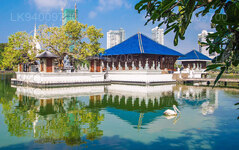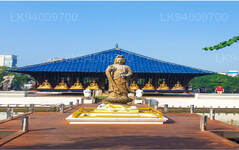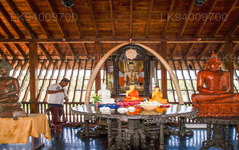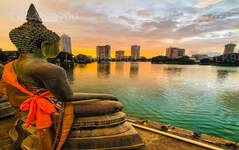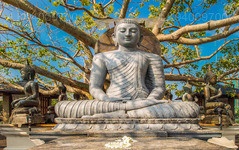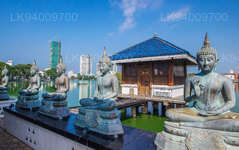
Ciudad de Colombo
Colombo, la capital de Sri Lanka, es una ciudad dinámica que combina tradición y modernidad. Luce arquitectura colonial, mercados animados y tranquilos templos budistas. Con una gastronomía diversa, un horizonte en crecimiento y hermosas playas, es un vibrante centro de negocios, cultura y turismo, ofreciendo una puerta de entrada para explorar las maravillas de Sri Lanka.
Seema Malaka
Within the heart of Colombo is the Gangarama Buddhist Temple. Built during the late 19th century for the Buddhists who lived in the capital city of Colombo; the temple sprawled over a large area of land and included several outer structures. The Seema Malaka is one of these. Originally, it was built with a foundation within the floor of Beira Lake, and was the image of stolidity. However, it was not able to withstand the marshy ground underneath the lake. By 1970 the Seema Malaka had sunk completely under the waters of Beira.
And then in 1976, Sir Geoffrey Bawa was hired to do this difficult construction design. He created three floating platforms interlinked by pontoon walkways and anchored to the base of the lake by way of stone pillars.
The light design ensured that the construction would not sink. The entire structure is connected to the shore using another pontoon bridge. He created a design that emulated the ancient monasteries of Anuradhapura and added his own signature modern twirl to it. Bawa was one of the most influential Asian architects of the mid to late 20th century and was well known for founding Tropical Modernism. This style is very apparent in the deep blue clay roof tiles of the main temple, the simplistic and yet delicate structure made of a collection of wooden spindles and banisters that lets plenty of air and light in, and the overall design that conforms to nature instead of fighting against it.Things to See
- The Central Platform: This platform has a number of Asian seated stone Buddhas along the perimeter of the platform. They are beautifully sculpted and come out well in photos. In the center is a room with slatted wooden walls. This comfortable place is used for meditation and yoga by visitors and devotees. It provides a relaxing view of the lake and its surroundings. It also has a beautiful large Buddha statue flanked by two giant elephant tusks. Before entering this room, you can take note of the Anuradhapura style dwarf guardian statues at the entrance; which are perfectly formed.
- The Northern Platform: This platform is sealed and is said to lead to the Treasury of the Truth. This houses a library of Buddhist texts and is only accessible by monks.
- The Courtyard: This is where the main part of Seema Malaka is. To one side of the courtyard, a comparatively small offshoot of the original sacred Bo tree in Anuradhapura grows out of a raised platform draped in prayer flags. It is flanked by Buddha statues of varied sizes – the biggest of which stands magnificently next to a small stupa. The courtyard has small rooms with wooden doors at the four corners. Within these are localized versions of Hindu Gods that the Buddhists worship as Devas. Just behind the main courtyard is a tier of stacked-up Buddha statues from Thailand. Close to this is the temple’s most surprising feature; a collection of vintage cars, presented by well-wishers over the years
- The Museum: On the way out of the entrance you can visit the museum. The temple museum has two big rooms overflowing with a treasure-trove of interesting objects; some collected for their symbolism, some for their artistic and/or financial value, and some just because. These include collections of ancient Sanskrit Ola leaf manuscripts, large sapphires and other precious stones, sandalwood and ivory carvings, brass statuettes of gods, jade & crystal monstrosities, elephant tusks, coins, innumerable Buddha images & statues of other Buddhist & Hindu deities, oil lamps, votive pagodas, old clocks, porcelain, ivory carvings, and even old gramophones. Overall they form what feels more like a cave of treasures that is definitely worth looking at.
Acerca del Distrito de Colombo
Colombo es la ciudad más grande y capital comercial de Sri Lanka. Se encuentra en la costa oeste de la isla, junto a Sri Jayewardenepura Kotte, la capital del país. Colombo es una ciudad vibrante y dinámica, con una mezcla de vida moderna y edificios y ruinas coloniales, y una población de 647.100 habitantes. La Región Metropolitana de Colombo, definida por los distritos de Colombo, Gampaha y Kalutara, tiene una población estimada de 5.648.000 habitantes y abarca una superficie de 3.694,20 km². Colombo es una ciudad multiétnica y multicultural. Es la ciudad más poblada de Sri Lanka, con 642.163 habitantes. La población de Colombo es una mezcla de numerosos grupos étnicos, principalmente cingaleses, moros y tamiles. También hay pequeñas comunidades de personas de origen chino, portugués, neerlandés, malayo e indio que viven en la ciudad, así como numerosos expatriados europeos. La gran mayoría de las empresas de Sri Lanka tienen su sede en Colombo. Algunas de las industrias incluyen productos químicos, textiles, vidrio, cemento, artículos de cuero, muebles y joyería. En el centro de la ciudad se encuentra el segundo edificio más alto del sur de Asia: el World Trade Centre.
Acerca de la Provincia Occidental
La Provincia Occidental es la más poblada de Sri Lanka. Alberga la capital legislativa, Sri Jayawardenepura Kotte, así como Colombo, el centro administrativo y comercial del país. Se divide en tres distritos principales: Colombo (642 km²), Gampaha (1386,6 km²) y Kalutara (1606 km²). Como centro económico de Sri Lanka, todas las grandes corporaciones locales e internacionales tienen presencia en la ciudad, al igual que las principales tiendas de diseño y comercios tradicionales. Prepárese para disfrutar de las compras en la Provincia Occidental. Con la mayor población de todas las provincias, casi todas las instituciones educativas de primer nivel de la isla se encuentran en la Provincia Occidental. Las universidades de la provincia incluyen la Universidad de Colombo, la Universidad de Sri Jayewardenepura, la Universidad de Kelaniya, la Universidad Abierta de Sri Lanka, la Universidad Budista y Pali de Sri Lanka, la Universidad de Defensa General Sir John Kotelawala y la Universidad de Moratuwa. La provincia occidental tiene la mayor cantidad de escuelas del país, que incluye escuelas nacionales, provinciales, privadas e internacionales.

